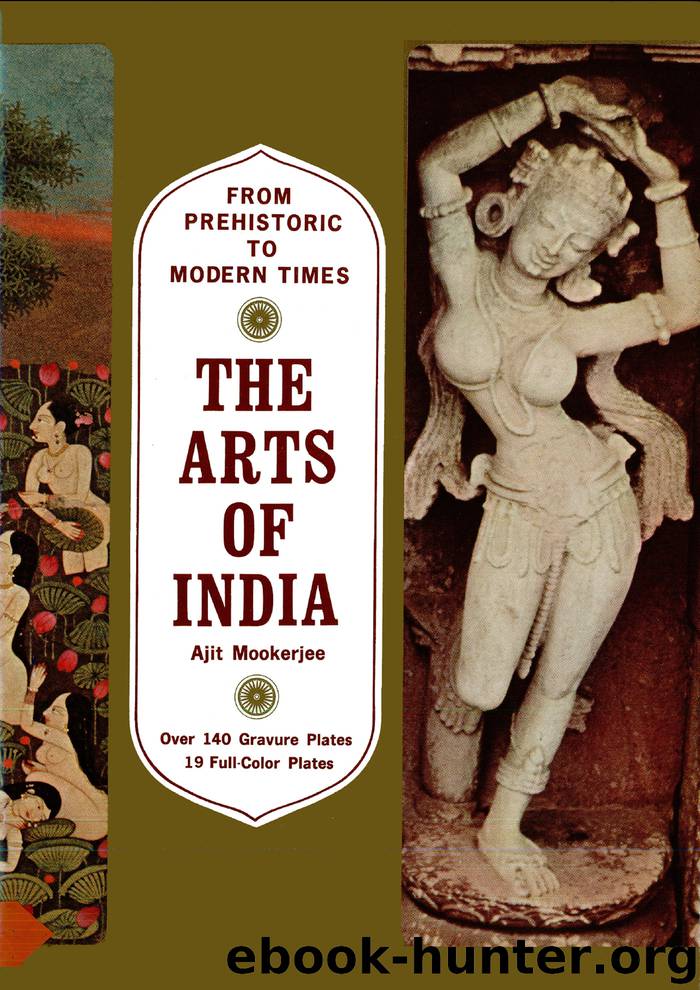The Arts of India by Ajit Mookerjee

Author:Ajit Mookerjee
Language: eng
Format: epub
ISBN: 9781462912636
Publisher: Tuttle Publishing
L. Tribal art: simple yet bold
Their usual themes are street scenes, popular folklore, festivals and family reunions, the joys and sorrows of everyday life together with biting satires on the vices of the decaying social order. Apart from its simple technique, Indian folk art by its nature and function, has useful lessons for creative artists in search of basic forms.
It is not a coincidence that the same basic forms run through the artistic expression of the few surviving tribes who still maintain a more or less primitive way of life. The plastic freedom has been kept alive in the wood carvings of Maria Gond tribes of Bastar State and particularly among the Nagas of Eastern India. The mind which expresses itself in direct simplicity and vigor of primitive art was poignantly brought out when a Naga youth, asked about his trouble, replied at once: "Whenever I love a girl, she immediately becomes pregnant." The thrust of his chisel has the same certainty and boldness.
Until recently nobody has taken the trouble of recording the artistic tradition of these people. The impact of Europe brought in an entirely new set of conditions which upset the social basis of primitive and folk art tradition of India. Even a century ago, the life of the guild artist was closely integrated in the economic life of the village. In exchange for his art products the artist was assigned a measure of land by the village community for his maintenance. Thus the other party to the deal was the collective organization of the village, and the artist was primarily an artist of the people. But with the break-up of the economic life of the villages that followed the British rule, the indigenous arts and crafts were not only seriously threatened but destroyed in many parts of the country.
The Europeans who came to India had no intention of settling here and were not really interested in a cultural synthesis between the East and the West. It was as if two closed systems faced each other and were not prepared either to influence or to imbibe anything from the contact. Nor was there any attempt to build up a new integration though there were sporadic efforts by a few western scholars who had been dazzled by the splendor of Indian civilization. The spirit of European art on the other hand could not be successfully assimilated by the Indian artists in their blind imitation. The result was Ravi Varma, whose syrupy pictures were an extreme example of philistine perversity.
But the period of fake European tradition did not last long. The wave of reformism, particularly in Bengal, needed a new vehicle of artistic expression. The rising Indian bourgeoisie took to classicism which was introduced by Abanindranath Tagore and carried all over India by his students. The outcome of this movement is well known as Bengal School of Art in which the name of Nandalal Bose stands out. He depicted the mythological stories in the traditional technique of the Ajanta mural paintings.
Download
This site does not store any files on its server. We only index and link to content provided by other sites. Please contact the content providers to delete copyright contents if any and email us, we'll remove relevant links or contents immediately.
| Decorative Arts | Design History & Criticism |
| Furniture Design | Industrial & Product Design |
| Interior & Home Design | Jewelry Design |
| Textile & Costume |
POP by Steven Heller(3307)
Japanese Design by Patricia J. Graham(3109)
The Power of Broke by Daymond John(2897)
Architecture 101 by Nicole Bridge(2764)
Indistractable: How to Control Your Attention and Choose Your Life by Nir Eyal(2334)
Fusion 360 for Makers by Lydia Sloan Cline(2308)
Batik by Rudolf Smend(2123)
Actionable Gamification: Beyond Points, Badges, and Leaderboards by Yu-kai Chou(2122)
Origami Art by Michael G. Lafosse & Richard L. Alexander(2065)
Homebody by Joanna Gaines(2031)
Whiskey in a Teacup by Reese Witherspoon(1936)
Worn in New York by Emily Spivack(1926)
Feng Shui by Stephen Skinner(1900)
Austin Kleon by Steal Like an Artist(1887)
Simple Gatherings by Melissa Michaels(1855)
Don't Make Me Think, Revisited: A Common Sense Approach to Web Usability by Steve Krug(1826)
Hygge: The Danish Art of Happiness by Marie Tourell Søderberg(1693)
The Joy of Hygge by Jonny Jackson(1685)
The Laws of Simplicity by John Maeda(1568)
